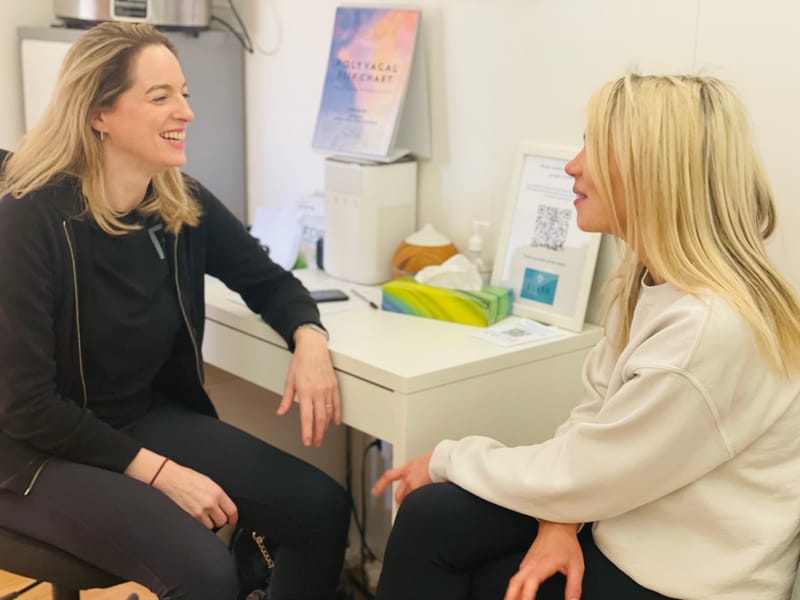Somatic Experiencing

What is Somatic Experiencing (SE)?
Somatic Experiencing is a body-oriented approach to relieving the physical, psychological and emotional effects of stress and trauma. It was developed by Dr Peter Levine and works on the principle that trauma gets trapped in the body, leading to some of the symptoms people with PTSD may experience. Many people who have experienced trauma can dissociate or disconnect from their bodies. SE helps them increase their awareness of their internal experience.
An SE therapist aims to help people to learn to relax and release stress or trauma. Talking therapies use a “top-down” approach, meaning cognitive and analytical skills are used to help a person make sense of their trauma. SE uses a “bottom-up” approach, meaning the bodily sensations help us process what has happened. A person may not be used to sitting with sensations or may not realise they are linked to emotions. SE does not involve a complete retelling of the trauma but some of the painful memories will come up. Susanna will work with these in a gentle way, so as not to overly activate your nervous system.
Trauma dysregulates the Autonomic Nervous System, having major effects on the body. The ANS functions as our danger detection system, constantly scanning for danger. Its three main states are:
- Safe: we are happy, relaxed and able to connect to others, our body is relaxed
- Fight or flight: danger is detected and our body prepares to fight or run away; your heart rate, breathing rate and blood pressure increase, cortisol and adrenaline are produced, blood is pumped to your muscles and away from your digestive system
- Freeze: when you can’t run or fight your brain shuts your body down. Heart rate and blood pressure decrease, you may feel numb, have difficulty concentrating or have muscle tension. This is similar to the way how an animal plays dead.
Danger can be physical or mental, the body reacts as if it is one and the same. In humans the brain can get stuck believing you are still in a state of danger, even if it is long past. This stops the complete discharge of survival energy that would have been expended after a fight or flight reaction. It does not allow the nervous system to regain its equilibrium. A highly-activated, incomplete biological response to threat may cause the stress or trauma symptoms we commonly see, such as addictions, chronic health conditions, chronic pain, poor gut health or mental health, and many more. Somatic Experiencing retrains the ANS (and you) to feel safe again.
You can book a FREE, 15-minute phone or video call with our Somatic Experiencing Practitioner Susanna Elias, to find out how she can help you. A one-hour taster session of somatic experiencing costs £40, with regular appointments costing £80 and a 10-session membership costing £720.
What might a Somatic Experiencing session look like?
Typically you will be sat in a chair with your feet on the floor (unless this is uncomfortable for you), with Susanna sat next to or opposite you, depending on your preference. She will start by helping you to feel more grounded, connected to the surface that you are on, which helps you sense your body. She will orientate you to the room, asking you to either look at something you find pleasant or look around the room. This helps your brain to realise it is in the here and now and is not in danger.
She will then help you to find a resource within your lived experience (although it can also be imaginary) that brings a smile to your face. This can be a person, place or thing. She will then use the language of the Autonomic Nervous System, sensation, to help you track how your body responds to your resource. Think of how your body responds to a hug with someone you are close to; your head may rest on them and your neck and shoulders may go floppy, your heart rate slows, your breathing deepens, you may even notice a spontaneous deep breath and sigh out.
This resourcing may be part of a session, a whole session or last several sessions depending on your needs. The aim is to deepen your access to resource to enable you to use it whenever you need to feel more regulated.
Susanna may then help you move back and forth between resource and minutely stressful situations or sensations in your body. Think of how your body responds to a fright, for example somebody pushing in front of you unexpectedly in traffic: your heart races, you may feel sweaty, your breathing may quicken, you may even notice that you stomach tenses or that your shoulders rise. In SE we are continually tracking sensation as it gives us the ability to slow down, access and process emotion and deeper layers of self-awareness and understanding that may not be initially self-evident. SE is not a talk therapy but some thoughts, emotions or memories may come up and you will be taught techniques to help make them more gentle and manageable.
In SE we peel back layers of stress and trauma gradually, always making sure you have enough resource to be able to cope with what comes up. This is the reason an SE session can often seem slow or even have a meditative quality.
Your SE session will usually finish with you feeling resourced and settled, calm and relaxed. It is common to feel tired or emotional after a session as you are working on a deep nervous system level. When survival energies are completed and discharged, people frequently experience a dramatic reduction in or disappearance of their symptoms. SE can allow people to deepen their sense of self and connection to others and create feelings of empowerment. The gentleness of SE helps people renegotiate and heal their stress or trauma at a pace that they can cope with rather than repeat or relive them.


